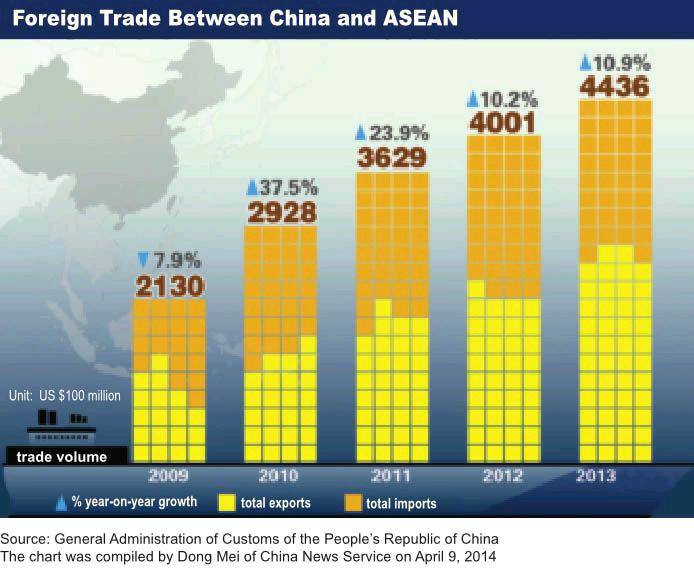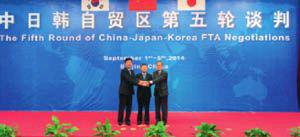Free Trade Area of the Asia-Pacific Promotes Regional Economic Integration
2014-12-20ByWANGYUZHU
By+WANG+YUZHU
THIS year marks the 25th anniversary of establishment of Asia-Pacific Economic Cooperation (APEC). In the past quarter century, APEC, as an important platform for Asia-Pacific cooperation, has made huge contributions to regional integration and to improving the livelihood of peoples in the locale. China is APECs largest developing member nation. In the past 20 or more years since its involvement in APEC, Chinas economy has made remarkable achievements throughout its gradual process of integration with the Asia-Pacific and world economies. Today, China is one of the worlds most important economies, and a key participant in international trade. Steadily growing imports reflect Chinas growing domestic consumption, and how the country is expanding from “world factory” to “world factory & world market.”APECs latest development goal is construction of the Free Trade Area of the Asia-Pacific (FTAAP), also an endeavor of great significance in realizing regional economic integration.
FTAAP towards Economic Integration
APEC first proposed the FTAAP concept in 2006. Eight years later, there has been no substantial progress. Today, with the appearance of copious free trade agreements and organizations, and rising levels of both integration and fragmentation, construction of the FTAAP suits the common interests of economies in the area. It is the main route towards maximizing regional interests, but will be difficult to expedite.
On the one hand, APEC members have been locked in competition over the past few years wherein each tries to bring about regional development that serves its particular interests. This has blurred the direction of APEC development. In 1994, APEC members adopted the Bogor Goals, which aim for free and open trade and investment in the Asia-Pacific region. At this time, when developing economies called for freer trade and investment to propel exports, the Bogor Goals invigorated APEC. After the 9/11 attacks, however, developed economies abandoned the Bogor Goals, so weakening APECs capability and effectiveness in promoting Asia-Pacific integration.
On the other hand, the year 2008 saw the start of U.S. participation in promoting the Trans-Pacific Partnership (TPP) Agreement within the APEC framework. This split APEC members into the TPP group, whose members lost interest in APEC, and the non-TPP group, who had to acknowledge APECs weakened role.
China hence opted to promote construction of the FTAAP in an attempt to rebuild a goal of cooperation that all APEC members recognize. Of course, the countrys attention focuses as much on regional connectivity as it does on construction of the FTAAP, because the former provides important support for the latter. Connectivity also plays a key role in building a solid Asia-Pacific partnership.
The China Year and Chinas Contribution
China assumed the chair of APEC in 2014. Under the theme of “Shaping the Future through Asia-Pacific Part- nership,” China focuses on advancing regional economic integration, promoting innovative development, economic reform and growth, and strengthening comprehensive connectivity and infrastructure development.
To achieve progress in Asia-Pacific integration, the priority of the 2014 APEC is to make concrete steps towards construction of the FTAAP. In other words, an FTAAP roadmap must be drafted. As regards promoting innovative development and economic reform and growth, this years focus is on the“five pillars,” namely, economic reform, new economy, innovative development, inclusive support, and urbanization. The aim of all five pillars is to seek out new engines of economic growth, maintain the momentum of Asia-Pacific economic development, and ensure the regions status as a growth engine of the world economy.
Compared to the issues of economic integration and connectivity, that of promoting innovative development and economic reform and growth entails more programs and pragmatic progress. A review of APECs history shows that APEC Economic Leaders Meeting declarations mention development and growth almost every year. But there is generally more talk than action. The 2014 meeting has for the first time explored systematic and pragmatic ways of promoting economic growth and development. It features deep discussions on innovative growth, avoiding the Middle Income Trap (MIT), green development, blue economy, Internet economy, and urbanization. As members have reached consensus on development, concrete results with regard to cooperation should be achieved this year.
Regional connectivity, encompassing infrastructure connectivity, institutional connectivity, and people-to-people connectivity, was on the APEC agenda in 2013. Cooperation under those themes is conducive to building all-round, multi-level, compound regional connectivity, thus realizing the big market, big connectivity, and big development of the Asia-Pacific region. In 2013, APEC published the APEC Framework on Connectivity, so establishing connectivity as a new pillar of APEC development.
APECs task this year is to draft a cooperation blueprint that will promote lasting practical cooperation towards connectivity. Right now, connectivity is a popular sector in regional cooperation, because it concerns the needs of developing economies. The Association of Southeast Asian Nations (ASEAN) hence adopted the Master Plan on ASEAN Connectivity. The China-ASEAN cooperation and the “10+3” cooperation(among the 10 members of ASEAN plus China, Japan and South Korea) accepted the concept before its introduction to APEC. This foundation makes it easier to carry forward.
Promoting APEC integration, connectivity, and regional growth is a pragmatic choice for China.
First, Chinas import market is growing rapidly; its imports will hit an estimated US $ 1 trillion in the next five years. Under the scenario of a booming market, therefore, Chinas promotion of regional integration signifies its resolve to share the fruits of economic development with other APEC members. Second, the construction of connectivity, especially infrastructure connectivity, demands ample funds. China supports ASEAN countries by including connectivity construction on the APEC agenda, so reflecting Chinas concern for developing countries, and readiness to make its contribution towards regional connectivity. At present, the Asian In- frastructure Investment Bank (AIIB), whose establishment China proposed, is under construction. Upon its establishment, the bank will give financial support to connectivity construction in the Asia-Pacific.
Cooperation in East Asia and Its Function
There are many bilateral and multilateral cooperation programs in East Asia that coexist with APEC. They include the ASEAN-China Free Trade Area that came into effect in 2010, and the China-South Korea Free Trade Area, China-Japan-South Korea Free Trade Area, and the Regional Comprehensive Economic Partnership (RCEP), which are still under negotiation. Those cooperation programs are part of efforts to promote Asia-Pacific economic integration.
Negotiations are underway to upgrade the ASEAN-China Free Trade Area, a free trade agreement that significantly boosts economic interdependence between China and ASEAN. It is also part of the foundation of the RCEP which, as earlier mentioned, is still under negotiation.
Negotiations on the China-JapanSouth Korea Free Trade Area also play an important supportive role in the RCEP. As China, Japan, and South Ko- rea are the predominant parties among the 16 RCEP members, establishment of the free trade area among this “big three” also plays a key role in RCEP construction. Despite adverse effects of the China-Japan relationship, negotiations on the China-Japan-South Korea Free Trade Area are progressing through joint efforts. The three parties have set a timetable in efforts to accelerate the process.
Negotiations on the China-South Korea Free Trade Area, believed to facilitate talks over the China-JapanSouth Korea Free Trade Area, are also under way. The word is that the two sides still have differences over certain industries. However, both governments display confidence that negotiations will conclude by the end of this year, which implies that the China-South Korea Free Trade Area is also likely to be established before year-end. Realization of the anticipated chain reaction – whereby the China-South Korea Free Trade Area hastens establishment of the ChinaJapan-South Korea Free Trade Area, so propelling RCEP negotiations towards concrete results – will substantially promote Asia-Pacific economic integration.
Win-win Prospects
The Asia-Pacific win-win strategy concept having been raised, APEC, as a platform to construct the Asia-Pacific win-win partnership, has reached a preliminary consensus on establishing the FTAAP. It might be said that the effect on APEC of the U.S. TPP program has been more or less remedied. This is indeed the issue of most concern to the 2014 APEC in China. It is to be expected that China, with fast economic growth and increasingly enhanced power, will play a growingly active and constructive role in APEC. The openness of the Chinese market and Chinas investment in regional cooperation implies a rise in potential APEC gains. This is Chinas contribution, and also one of the sources through which APEC can achieve its win-win prospects in the Asia-Pacific.
